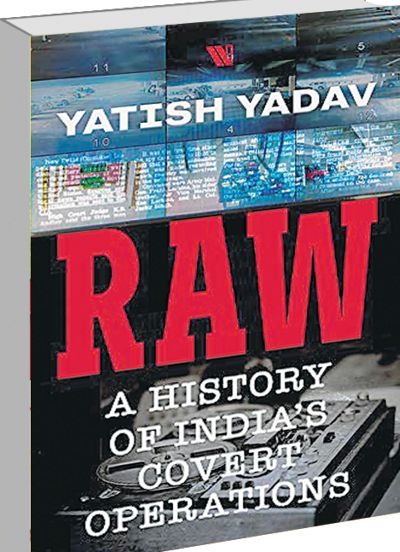Raw: A History of India’s Covert Operations; by Yatish Yadav, Westland, Pages 391, Rs 799
Book Title: Raw: A History of India’s Covert Operations
Author: Yatish Yadav
Rahul Bedi
Veteran Indian spooks narrate the deliciously sardonic tale of a purported exchange sometime in the mid-1970s, between then Prime Minister Indira Gandhi and Ram Nath Kao, the founding head of India’s external intelligence gathering agency, the Research and Analysis Wing (RAW).
During their routine morning interaction, in which Kao presented his customary single-page daily intelligence report to the PM, she is believed to have looked quizzically at the intelligence czar over her spectacle rims and acerbically remarked: “Ram Nath, I seem to recall having read this earlier today — in the morning newspapers.”
 The hagiographic ‘RAW: A History of India’s Covert Operations’ by Yatish Yadav, however, attempts, albeit feebly, to disprove this exchange in what appears to be a ‘sponsored’ chronicle of India’s 52-year-old overseas spy agency. Woefully, what emerges 391 pages later as the unintended consequence of Yadav’s labour, is a bland and dreary account of a vital intelligence organisation with a fetching acronym, but limited oomph and tradecraft.
The hagiographic ‘RAW: A History of India’s Covert Operations’ by Yatish Yadav, however, attempts, albeit feebly, to disprove this exchange in what appears to be a ‘sponsored’ chronicle of India’s 52-year-old overseas spy agency. Woefully, what emerges 391 pages later as the unintended consequence of Yadav’s labour, is a bland and dreary account of a vital intelligence organisation with a fetching acronym, but limited oomph and tradecraft.
The RAW was founded in late 1968 by the intellectually razor-sharp and dapper Kao, with some 250 Intelligence Bureau officers, who in their initial years, were known as ‘Kaoboys’. In his oleaginous history of this agency — and its operatives — it seems Yadav, a New Delhi-based investigative journalist, was provided access to normally unobtainable classified official documents, including a raft of secret inter and intra-departmental and hush-hush cross-ministerial exchanges and analyses.
Despite that advantage, Yadav unimaginatively weaves a tale, shorn of excitement or chutzpah, of ingenuous and somewhat amateurish RAW agents with pseudonyms and supposed ‘expertise in spy tradecraft’ operating undercover across India’s neighbourhood in Afghanistan, Pakistan, Bangladesh, Nepal, Sri Lanka and further afield in Fiji and West Asia.
Several of its 11 chapters are dedicated to extended RAW operations in the US, Canada and other European capitals for nearly two decades, till the late 1990s targeting Sikh separatists seeking Khalistan via an amalgam of ham-handed psyops, inept recruitment of moles and amateurish cloak-and-dagger routines.
Yadav’s heroes too appear pedestrian, despite slipshod attempts to dress them up. Operating under the nom de guerre of Dinesh Mathur, for instance, was one such RAW operative posted in the US in the late 1980s, with the avowed inborn skill of ‘tracking down targets and sniffing out information without inviting attention’.
Mathur, who is one of the more animated RAW agents portrayed by Yadav, also displays what passes for high principles of espionage philosophy. “There is no template for spying, for which every tool available has to be used and exploited. Spying is a dirty job,” Mathur confesses loftily to a wide-eyed Yadav.
Barring l’ affaire Rabindra Singh, the RAW double agent who defected under CIA patronage to the US in 2004, and reportedly died 12 years later in a road accident in Maryland, the author infers that RAW, renowned for its numerous gaffes, repeated blunders and operational failures, has done little or no wrong in its role as India’s ‘first line of defence against overseas threats’.
In the chapter on Singh, prosaically entitled ‘Hunting the R&AW traitor’, Yadav ingenuously declares that it was “considered the duty of every spy handling state secrets to ensure their safety, prevent them from falling into the hands of unauthorised people and ensure that their contents were not disclosed to anyone”. Undeterred, he goes on to banally argue that unless persons employed in clandestine work make the utmost effort to protect classified documents and information, it would be impossible to prevent leaks.
Yadav’s account also doubles as a primer for spooks. He details the RAW’s training regimen that includes instructions to its operatives on how not to discuss sensitive matters on possibly compromised telephones, and to incinerate sensitive documents. However, whilst performing the latter task, the RAW directs ‘cyber officers supervising the burning of such papers not to leave their position near the incinerator till only ashes are left’. Carbon papers, previously used before the advent of computers, too were to be similarly burnt.
Nevertheless, the fledgling RAW’s operational apogee emanated in 1971 when it successfully administered its death-by-a-thousand-cuts campaign against the Pakistani military government in East Pakistan. This eventually precipitated war, following which Bangladesh was born and in the RAW’s assessments, East Pakistan’s disappearance eliminated a grave security threat to India for several decades.
Yadav, however, pays appreciative tribute to RAW’s unobtrusive women operatives and analysts — but only in his prologue — who he credits with shaping major operations like tracking down terror financing in Pakistan. But judging by the yardstick of histories of other spy networks, Yadav could have done better justice to the RAW, known irreverently in security circles as the ‘Joke and Dagger’ Department.














